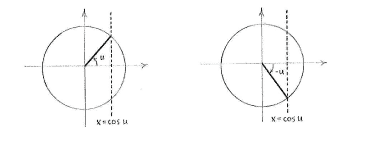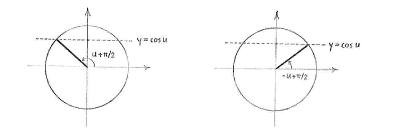Lösung 4.4:7c
Aus Online Mathematik Brückenkurs 1
K (hat „Solution 4.4:7c“ nach „Lösung 4.4:7c“ verschoben: Robot: moved page) |
|||
| Zeile 1: | Zeile 1: | ||
| - | + | Um die Gleichung <math>\cos 3x = \sin 4x</math> zu lösen, betrachten wir zuerst die allgemeine Gleichung | |
| - | + | ||
| - | + | ||
| - | + | ||
{{Abgesetzte Formel||<math>\cos u=\cos v\,\textrm{.}</math>}} | {{Abgesetzte Formel||<math>\cos u=\cos v\,\textrm{.}</math>}} | ||
| - | + | Wir wissen dass es für ein fixes ''u'' zwei Winkeln im Einheitskreis gibt für welche die Gleichung erfüllt ist, nämlich <math>v=u</math> und <math>v=-u</math>. | |
[[Image:4_4_7_c1.gif|center]] | [[Image:4_4_7_c1.gif|center]] | ||
| - | + | Jetzt drehen wir den Einheitskreis den Winkel <math>\pi/2</math> gegen den Uhrzeiger. Die Gerade <math>x=\cos u</math> bekommt dann <math>y=\cos u</math> und die Winkeln ''u'' und -''u'' bekommen <math>u+\pi/2</math> und <math>-u+\pi/2</math>, | |
[[Image:4_4_7_c2.gif|center]] | [[Image:4_4_7_c2.gif|center]] | ||
| - | + | Die Winkeln <math>u+\pi/2</math> und <math>-u+\pi/2</math> haben daher dieselbe ''y''-Koordinate, und daher denselben Sinus. Also ist die Gleichung | |
{{Abgesetzte Formel||<math>\cos u = \sin v</math>}} | {{Abgesetzte Formel||<math>\cos u = \sin v</math>}} | ||
| - | + | für ein fixes ''u'' erfüllt wenn <math>v = \pm u + \pi/2</math>, und allgemein wenn | |
| - | {{Abgesetzte Formel||<math>v = \pm u + \frac{\pi}{2} + 2n\pi\qquad</math> | + | {{Abgesetzte Formel||<math>v = \pm u + \frac{\pi}{2} + 2n\pi\qquad</math>}} |
| - | + | In unseren Fall ist die Gleichung <math>\cos 3x = \sin 4x</math> erfüllt wenn | |
{{Abgesetzte Formel||<math>4x = \pm 3x + \frac{\pi}{2} + 2n\pi\,\textrm{.}</math>}} | {{Abgesetzte Formel||<math>4x = \pm 3x + \frac{\pi}{2} + 2n\pi\,\textrm{.}</math>}} | ||
| - | + | und also bekommen wir die allgemeinen Lösungen | |
{{Abgesetzte Formel||<math>\left\{\begin{align} | {{Abgesetzte Formel||<math>\left\{\begin{align} | ||
| Zeile 32: | Zeile 29: | ||
x &= \frac{\pi}{14} + \frac{2}{7}\pi n\,, | x &= \frac{\pi}{14} + \frac{2}{7}\pi n\,, | ||
\end{align}\right.</math>}} | \end{align}\right.</math>}} | ||
| - | |||
| - | where ''n'' is an arbitrary integer. | ||
Version vom 12:06, 7. Apr. 2009
Um die Gleichung \displaystyle \cos 3x = \sin 4x zu lösen, betrachten wir zuerst die allgemeine Gleichung
| \displaystyle \cos u=\cos v\,\textrm{.} |
Wir wissen dass es für ein fixes u zwei Winkeln im Einheitskreis gibt für welche die Gleichung erfüllt ist, nämlich \displaystyle v=u und \displaystyle v=-u.
Jetzt drehen wir den Einheitskreis den Winkel \displaystyle \pi/2 gegen den Uhrzeiger. Die Gerade \displaystyle x=\cos u bekommt dann \displaystyle y=\cos u und die Winkeln u und -u bekommen \displaystyle u+\pi/2 und \displaystyle -u+\pi/2,
Die Winkeln \displaystyle u+\pi/2 und \displaystyle -u+\pi/2 haben daher dieselbe y-Koordinate, und daher denselben Sinus. Also ist die Gleichung
| \displaystyle \cos u = \sin v |
für ein fixes u erfüllt wenn \displaystyle v = \pm u + \pi/2, und allgemein wenn
| \displaystyle v = \pm u + \frac{\pi}{2} + 2n\pi\qquad |
In unseren Fall ist die Gleichung \displaystyle \cos 3x = \sin 4x erfüllt wenn
| \displaystyle 4x = \pm 3x + \frac{\pi}{2} + 2n\pi\,\textrm{.} |
und also bekommen wir die allgemeinen Lösungen
| \displaystyle \left\{\begin{align}
x &= \frac{\pi}{2} + 2n\pi\,,\\[5pt] x &= \frac{\pi}{14} + \frac{2}{7}\pi n\,, \end{align}\right. |


